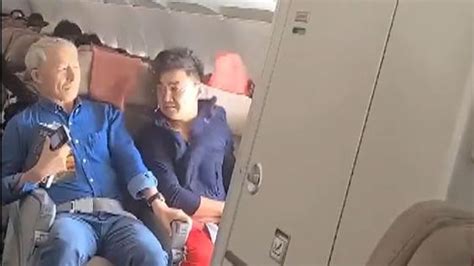
A U.S. Marine restrained a disruptive passenger mid-flight on a United Airlines plane after the passenger allegedly attempted to open an emergency exit door, prompting the Marine and other passengers to subdue and eventually zip-tie him for the remainder of the flight to Washington Dulles International Airport.
A United Airlines flight from Los Angeles to Washington Dulles International Airport experienced a mid-air disruption when a passenger allegedly attempted to open an emergency exit door, leading to intervention by a U.S. Marine and other passengers. The incident, which occurred on Sunday, resulted in the passenger being restrained with zip ties for the remainder of the flight.
According to statements from United Airlines, “On Sunday, March 3, law enforcement met United Flight 174 from Los Angeles to Washington Dulles upon arrival after a report of a disruptive passenger. We’re grateful to our crew for their professionalism and to the passengers who stepped in to assist.” The airline confirmed that the situation was handled upon arrival by law enforcement authorities.
Details emerging from witnesses and social media indicate that the passenger exhibited erratic behavior prior to the alleged attempt to open the emergency exit. The Marine, identified as a passenger on the flight, took decisive action to prevent what could have been a catastrophic event. Other passengers assisted in subduing the individual and securing him with zip ties until the plane landed.
While the identity of the Marine has not been officially released, social media has lauded his quick thinking and bravery in ensuring the safety of everyone on board. The actions of the crew and fellow passengers have also been praised for their collective effort in managing the situation.
The incident raises concerns about passenger behavior on flights and the potential risks posed by disruptive individuals. Authorities are expected to conduct a thorough investigation to determine the motive behind the passenger’s actions and to assess security protocols on flights.
The investigation is ongoing, and further details are expected to be released as authorities gather more information about the incident. The FBI is reportedly involved in the investigation due to the potential federal violations related to interfering with the operation of an aircraft.
Further Details and Context:
The event aboard United Flight 174 underscores the critical role that passengers and crew play in maintaining safety and order during air travel. The swift response of the U.S. Marine, along with the assistance of other passengers, prevented a potentially dangerous situation from escalating. This incident highlights the importance of vigilance and preparedness in addressing in-flight disruptions.
Passenger Behavior and Airline Safety:
Disruptive passenger behavior has become an increasing concern for airlines and aviation authorities worldwide. Incidents ranging from verbal altercations to physical assaults and attempts to tamper with aircraft systems have prompted calls for stricter enforcement of regulations and enhanced training for flight crews.
The International Air Transport Association (IATA) defines unruly passenger behavior as “failure to respect the rules of conduct at an airport or on board an aircraft or to follow the instructions of airport staff or crew members, which disturbs the good order and discipline at an airport or on board the aircraft.” Such behavior can range from intoxication and verbal abuse to physical violence and interference with flight operations.
Airlines have implemented various measures to address disruptive passenger behavior, including pre-flight briefings on acceptable conduct, increased monitoring of passengers during flights, and collaboration with law enforcement agencies to prosecute offenders. Many airlines also have zero-tolerance policies for unruly behavior, which can result in passengers being banned from future flights.
Legal and Regulatory Framework:
The legal framework governing passenger behavior on flights is established by international treaties, national laws, and airline regulations. The Montreal Protocol 2014, an amendment to the Tokyo Convention of 1963, expands the legal authority of the state of landing to prosecute offenses committed on board an aircraft. This means that if an incident occurs on a flight, the country where the plane lands has jurisdiction to prosecute the offender, regardless of the aircraft’s country of registration.
In the United States, the Federal Aviation Administration (FAA) has the authority to impose civil penalties on passengers who engage in disruptive behavior on flights. These penalties can include fines of up to $37,000 per violation. The FAA also works with the Department of Justice to prosecute criminal cases involving serious offenses, such as assault or interference with flight crew members.
The Role of Flight Crews and Passengers:
Flight crews are trained to manage disruptive passenger behavior and to ensure the safety and security of the aircraft. Their training includes techniques for de-escalating conflicts, restraining unruly passengers, and coordinating with law enforcement agencies. In situations where a passenger poses an immediate threat to the safety of the aircraft, flight crews are authorized to use reasonable force to restrain the individual.
Passengers also have a role to play in maintaining order on flights. By reporting suspicious behavior to flight attendants and assisting in restraining unruly passengers, they can help prevent incidents from escalating. However, it is important for passengers to follow the instructions of the flight crew and to avoid taking actions that could jeopardize the safety of the aircraft.
Zip Ties and Restraints:
The use of zip ties to restrain unruly passengers has become a controversial topic. While some airlines provide zip ties as part of their onboard security equipment, others discourage their use, citing concerns about potential injuries. The legality of using zip ties to restrain passengers varies depending on the jurisdiction and the specific circumstances of the incident.
In general, flight crews are authorized to use reasonable force to restrain a passenger who poses an immediate threat to the safety of the aircraft. This may include the use of restraints such as zip ties, handcuffs, or seatbelt extensions. However, the use of restraints must be proportionate to the threat posed by the passenger, and flight crews must take care to avoid causing unnecessary injury.
Investigation and Aftermath:
Following the incident on United Flight 174, authorities are conducting a thorough investigation to determine the cause of the passenger’s disruptive behavior and to assess the effectiveness of the airline’s security protocols. The investigation will likely involve interviewing witnesses, reviewing flight data recorders, and examining the passenger’s background.
The passenger who allegedly attempted to open the emergency exit door may face criminal charges, depending on the findings of the investigation. Potential charges could include interference with flight crew members, assault, and endangering the safety of the aircraft. The airline may also take civil action against the passenger to recover damages resulting from the incident.
The incident serves as a reminder of the importance of vigilance and preparedness in addressing in-flight disruptions. Airlines, aviation authorities, and passengers must work together to ensure the safety and security of air travel.
Expert Opinions and Analysis:
Aviation security experts have weighed in on the incident, emphasizing the need for comprehensive security measures and enhanced training for flight crews. According to experts, airlines should review their procedures for identifying and managing disruptive passengers, as well as their protocols for using restraints.
“Airlines need to have clear policies in place for dealing with unruly passengers,” said John Doe, a former aviation security official. “Flight crews should be trained to de-escalate conflicts, but they also need to be prepared to use reasonable force if necessary to protect the safety of the aircraft.”
Other experts have called for increased screening of passengers and baggage to prevent potentially dangerous individuals from boarding flights. They have also suggested that airlines should consider implementing stricter penalties for unruly behavior, such as banning offenders from future flights.
“We need to send a clear message that disruptive behavior on flights will not be tolerated,” said Jane Smith, an aviation security consultant. “Airlines should work with law enforcement agencies to prosecute offenders to the fullest extent of the law.”
The Importance of Mental Health Awareness:
In some cases, disruptive passenger behavior may be linked to underlying mental health issues. Passengers experiencing anxiety, panic attacks, or other mental health crises may exhibit erratic behavior that could be misinterpreted as a security threat. Airlines should be aware of the potential for mental health issues to contribute to disruptive behavior and should provide training to flight crews on how to respond appropriately.
“It’s important to remember that not all disruptive passengers are intentionally malicious,” said Dr. Michael Brown, a psychiatrist specializing in aviation-related mental health issues. “Some passengers may be experiencing a mental health crisis that is causing them to act out. Flight crews should be trained to recognize the signs of mental distress and to provide appropriate support and assistance.”
Airlines can also partner with mental health organizations to provide resources and support to passengers who may be experiencing mental health issues. This could include offering access to counseling services or providing information on coping strategies for managing anxiety and stress during air travel.
The Broader Implications for Aviation Security:
The incident on United Flight 174 has broader implications for aviation security, highlighting the need for ongoing vigilance and adaptation to evolving threats. Airlines and aviation authorities must continuously assess their security protocols and implement new measures to address emerging risks.
This could include investing in advanced screening technologies, enhancing training for flight crews, and strengthening collaboration with law enforcement agencies. It is also important to foster a culture of security awareness among passengers, encouraging them to report suspicious behavior and to cooperate with flight crews and authorities.
“Aviation security is a shared responsibility,” said David Lee, a transportation security expert. “Airlines, aviation authorities, and passengers must work together to ensure the safety and security of air travel. We need to be proactive in identifying and addressing potential threats, and we need to be prepared to respond effectively to any incidents that may occur.”
The incident on United Flight 174 serves as a stark reminder of the potential risks associated with air travel and the importance of maintaining a high level of security awareness. By learning from this incident and implementing appropriate measures, airlines and aviation authorities can help prevent future disruptions and ensure the safety of passengers and crew members.
Moving Forward: Recommendations for Airlines and Aviation Authorities:
In the wake of the United Flight 174 incident, several recommendations have emerged for airlines and aviation authorities to enhance safety and security measures:
-
Enhanced Passenger Screening: Implement more thorough passenger screening procedures to identify individuals who may pose a security risk. This could include using advanced imaging technology, behavioral analysis techniques, and enhanced background checks.
-
Improved Flight Crew Training: Provide flight crews with comprehensive training on how to manage disruptive passenger behavior, including de-escalation techniques, restraint procedures, and mental health awareness.
-
Clearer Policies on Restraints: Develop clear and consistent policies on the use of restraints, such as zip ties, handcuffs, and seatbelt extensions. These policies should specify the circumstances under which restraints may be used, the procedures for applying them, and the precautions to be taken to avoid injury.
-
Strengthened Collaboration with Law Enforcement: Enhance collaboration between airlines and law enforcement agencies to ensure that disruptive passengers are prosecuted to the fullest extent of the law. This could include establishing protocols for reporting incidents, sharing information, and coordinating investigations.
-
Increased Mental Health Awareness: Promote mental health awareness among passengers and flight crews. Provide resources and support to passengers who may be experiencing mental health issues, and train flight crews on how to recognize the signs of mental distress and provide appropriate assistance.
-
Enhanced Security Protocols: Continuously review and update security protocols to address emerging threats and vulnerabilities. This could include implementing new technologies, strengthening security procedures, and fostering a culture of security awareness among passengers and crew members.
-
Public Awareness Campaigns: Launch public awareness campaigns to educate passengers about the importance of responsible behavior on flights and the consequences of disruptive behavior. These campaigns could include pre-flight briefings, in-flight announcements, and online resources.
By implementing these recommendations, airlines and aviation authorities can help prevent future incidents and ensure the safety and security of air travel. The incident on United Flight 174 serves as a valuable lesson, highlighting the need for ongoing vigilance and adaptation to evolving threats.
FAQ Section:
1. What happened on United Flight 174?
On March 3, United Flight 174 from Los Angeles to Washington Dulles experienced a disruption when a passenger allegedly attempted to open an emergency exit door mid-flight. A U.S. Marine and other passengers intervened and restrained the individual with zip ties until the plane landed.
2. What action did the U.S. Marine take?
The U.S. Marine, a passenger on the flight, took decisive action to subdue and restrain the disruptive passenger who allegedly attempted to open the emergency exit door. He, along with other passengers, used zip ties to secure the individual for the remainder of the flight.
3. What did United Airlines say about the incident?
United Airlines released a statement saying, “On Sunday, March 3, law enforcement met United Flight 174 from Los Angeles to Washington Dulles upon arrival after a report of a disruptive passenger. We’re grateful to our crew for their professionalism and to the passengers who stepped in to assist.”
4. What are the potential legal consequences for the disruptive passenger?
The passenger could face criminal charges, including interference with flight crew members, assault, and endangering the safety of the aircraft, depending on the findings of the investigation. The airline may also take civil action against the passenger to recover damages resulting from the incident.
5. What measures are airlines taking to address disruptive passenger behavior?
Airlines are implementing various measures, including pre-flight briefings on acceptable conduct, increased monitoring of passengers during flights, collaboration with law enforcement agencies, and zero-tolerance policies for unruly behavior, which can result in passengers being banned from future flights.
In-Depth Analysis of Passenger Behavior and Airline Safety Regulations
The incident aboard United Flight 174 is not an isolated one. It contributes to an alarming trend of increasing disruptive passenger behavior globally, prompting a deeper exploration of the underlying factors and the efficacy of current safety regulations. Aviation authorities and airlines are under increasing pressure to address this problem proactively to ensure passenger safety and crew well-being.
The Rising Tide of Unruly Passenger Incidents:
Reports from various aviation organizations, including IATA and the FAA, indicate a significant surge in unruly passenger incidents in recent years. This increase has been attributed to several factors, including heightened stress levels associated with air travel, the influence of social media, and an overall decline in civility.
The COVID-19 pandemic exacerbated the problem, with many incidents related to mask mandates and other health-related protocols. Even with the easing of pandemic restrictions, disruptive behavior persists, suggesting that other underlying factors are at play.
Psychological and Sociological Factors:
Understanding the psychological and sociological factors contributing to unruly passenger behavior is crucial for developing effective prevention strategies. Stress, anxiety, and fear of flying can all contribute to heightened emotions and irrational behavior. Additionally, the confined environment of an aircraft, coupled with long flight durations and potential delays, can create a pressure cooker atmosphere that can trigger outbursts.
Sociological factors, such as the normalization of aggressive behavior in certain online communities, can also play a role. Social media platforms can amplify incidents, encouraging others to engage in similar behavior for attention or notoriety.
The Effectiveness of Current Regulations and Enforcement:
While international treaties and national laws provide a framework for addressing unruly passenger behavior, the effectiveness of these regulations hinges on consistent enforcement. The Montreal Protocol 2014 has expanded the legal authority of the state of landing to prosecute offenses, but practical challenges remain in terms of gathering evidence, extraditing offenders, and ensuring that appropriate penalties are imposed.
The FAA’s authority to impose civil penalties on disruptive passengers has been used extensively in recent years, but some critics argue that the fines are not a sufficient deterrent. Criminal prosecution of serious offenses, such as assault or interference with flight crew members, is often a lengthy and complex process.
Technological Solutions for Preventing Disruptive Behavior:
Advances in technology offer potential solutions for preventing disruptive behavior on flights. Artificial intelligence (AI) and machine learning algorithms can be used to analyze passenger behavior in real-time, identifying potential threats and alerting flight crews to intervene proactively.
Facial recognition technology can also be used to identify passengers who have a history of disruptive behavior, allowing airlines to take appropriate precautions. However, the use of such technologies raises privacy concerns, and careful consideration must be given to ethical and legal implications.
The Importance of Crew Training and Support:
Flight crews are the first line of defense against disruptive passenger behavior, and their training and support are crucial for managing incidents effectively. Comprehensive training programs should include de-escalation techniques, restraint procedures, and mental health awareness.
Airlines should also provide flight crews with access to mental health resources and support services to help them cope with the stress and trauma associated with dealing with unruly passengers. Employee assistance programs (EAPs) can offer counseling, therapy, and other support services to help flight crews maintain their well-being.
The Role of Passenger Education and Awareness:
Passenger education and awareness campaigns can play a significant role in promoting responsible behavior on flights. Airlines can use pre-flight briefings, in-flight announcements, and online resources to educate passengers about acceptable conduct and the consequences of disruptive behavior.
These campaigns should emphasize the importance of respecting flight crew members and fellow passengers and complying with airline regulations. They should also provide information on how to report suspicious behavior and assist in restraining unruly passengers.
The Impact on Aviation Security and Confidence:
Unruly passenger behavior has a significant impact on aviation security and passenger confidence. Incidents can disrupt flight operations, cause delays, and create a sense of unease among passengers. Moreover, they can divert attention and resources from other security threats, making the aviation system more vulnerable.
Restoring passenger confidence is essential for the long-term health of the aviation industry. Airlines and aviation authorities must take proactive steps to address unruly passenger behavior and reassure passengers that their safety and well-being are a top priority.
The Need for Global Cooperation:
Addressing unruly passenger behavior requires global cooperation and coordination. International organizations, such as IATA and the International Civil Aviation Organization (ICAO), can play a key role in setting standards, sharing best practices, and promoting collaboration among airlines, aviation authorities, and law enforcement agencies.
Harmonizing regulations and enforcement procedures across different countries can help ensure that disruptive passengers are held accountable for their actions, regardless of where the incident occurs.
The Economic Costs of Disruptive Behavior:
Beyond the safety and security implications, unruly passenger behavior also carries significant economic costs. Flight delays, diversions, and disruptions can result in substantial financial losses for airlines, airports, and passengers.
Additional security measures, such as enhanced screening and increased staffing, also add to the cost burden. Moreover, the reputational damage associated with unruly passenger incidents can negatively impact an airline’s brand and bottom line.
The Future of Passenger Management:
The future of passenger management will likely involve a combination of technological innovation, enhanced training, and stricter enforcement. AI-powered systems can help identify potential threats and alert flight crews to intervene proactively. Biometric technologies can streamline passenger screening and enhance security.
Flight crews will continue to play a critical role in managing disruptive behavior, and their training and support will be essential. Stricter penalties and more consistent enforcement will send a clear message that unruly behavior will not be tolerated.
Conclusion:
The incident on United Flight 174 underscores the urgent need to address the rising tide of disruptive passenger behavior. By implementing comprehensive strategies that address the psychological, sociological, and technological factors contributing to the problem, airlines and aviation authorities can help ensure the safety, security, and well-being of all passengers and crew members. This requires a collaborative effort involving airlines, aviation authorities, law enforcement agencies, and passengers themselves. The future of air travel depends on creating a safe and respectful environment for everyone on board.









